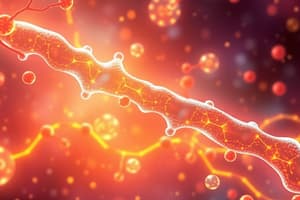Podcast
Questions and Answers
Which neurotransmitter is primarily responsible for sympathetic postganglionic synapses?
Which neurotransmitter is primarily responsible for sympathetic postganglionic synapses?
- Serotonin
- Dopamine
- Acetylcholine
- Noradrenaline (correct)
What is one effect of parasympathetic stimulation mediated by acetylcholine?
What is one effect of parasympathetic stimulation mediated by acetylcholine?
- Lowered blood pressure (correct)
- Dilation of the pupils
- Increased heart rate
- Inhibited peristalsis
Which of the following is NOT a function associated with sympathetic stimulation?
Which of the following is NOT a function associated with sympathetic stimulation?
- Raises blood pressure
- Increased blood flow to the skin (correct)
- Stimulates heartbeat
- Inhibits peristalsis
Which of the following is true about acetylcholine (ACh) in the context of both the sympathetic and parasympathetic systems?
Which of the following is true about acetylcholine (ACh) in the context of both the sympathetic and parasympathetic systems?
What is one of the effects of acetylcholine in the gastrointestinal (GI) tract during parasympathetic stimulation?
What is one of the effects of acetylcholine in the gastrointestinal (GI) tract during parasympathetic stimulation?
Which effect is associated with sympathetic nervous system activation?
Which effect is associated with sympathetic nervous system activation?
Which of the following neurotransmitters is mainly associated with the preganglionic neurons in the sympathetic nervous system?
Which of the following neurotransmitters is mainly associated with the preganglionic neurons in the sympathetic nervous system?
What physiological change occurs when noradrenaline is released during sympathetic stimulation?
What physiological change occurs when noradrenaline is released during sympathetic stimulation?
What is the primary function of cholinergic agents?
What is the primary function of cholinergic agents?
Which type of receptor does acetylcholine bind to that functions as an ion channel?
Which type of receptor does acetylcholine bind to that functions as an ion channel?
What structural feature do nicotinic receptors possess?
What structural feature do nicotinic receptors possess?
What initiates the opening of the central pore in nicotinic receptors?
What initiates the opening of the central pore in nicotinic receptors?
Which statement accurately describes muscarinic receptors?
Which statement accurately describes muscarinic receptors?
What role do muscarinic receptors play in the body?
What role do muscarinic receptors play in the body?
What is a characteristic feature of the binding site in nicotinic receptors?
What is a characteristic feature of the binding site in nicotinic receptors?
Which of the following accurately describes the action potential generated by nicotinic receptors?
Which of the following accurately describes the action potential generated by nicotinic receptors?
Study Notes
Organic Pharmaceutical Chemistry II
- This lecture is about Cholinergic Drugs and Related Agents.
- Acetylcholine (ACh) is the neurotransmitter in the parasympathetic and sympathetic nervous systems.
- It is also found in the neuromuscular junction and the central nervous system (CNS).
- Parasympathetic stimulation causes:
- Slowing of the heart rate.
- Lowering of blood pressure.
- Constriction of the pupils.
- Increased blood flow to the skin and viscera.
- Peristalsis of the GI tract.
- Sympathetic stimulation causes:
- Stimulates heartbeat.
- Raises blood pressure.
- Dilates the pupils.
- Dilates the trachea and bronchi.
- Stimulates the conversion of liver glycogen into glucose.
- Shunts blood away from the skin and viscera to the skeletal muscles, brain, and heart.
- Inhibits peristalsis in the GI tract.
- Inhibits contraction of the bladder and rectum.
- Cholinergic agents either mimic or block the action of ACh.
- Cholinergic receptors are divided into two classes:
- Nicotinic receptors
- Muscarinic receptors
Nicotinic Receptors
- These receptors are ionotropic, meaning they themselves are ion channels.
- They are made up of five subunit polypeptide chains (pentameric structures).
- Two of these chains are identical (2α).
- The other chains are β, γ, and δ (ε).
- The α chains contain a binding site for the quaternary ammonium group of ACh.
- When stimulated by ACh or nicotine, the receptor's shape changes, which opens the ion channel and allows cations to flow through.
- This causes depolarization and the generation of an action potential.
Muscarinic Receptors
- These receptors play a role in the regulation of organs in the autonomic nervous system to maintain homeostasis.
- They activate guanosine triphosphate (GTP)-binding proteins (G-proteins).
- Muscarinic receptor subtypes are located in the CNS and peripheral nervous system.
Studying That Suits You
Use AI to generate personalized quizzes and flashcards to suit your learning preferences.
Related Documents
Description
This quiz focuses on cholinergic drugs and their effects on the nervous system, including their roles in parasympathetic and sympathetic stimulation. Topics covered include acetylcholine, its functions, and the physiological responses it triggers in various body systems.




